The Name of the Game – Introduction
The Name of the Game is an investigation into how design competitions and awards influence the designers' working conditions. How do they affect the social relations between practitioners? Which kind of practices are promoted and which are obscured?
The study includes a statistical survey and interviews with practitioners. This website presents our research, a summary of our thesis and further reading.
Although the study is set in a Swedish context with a focus on graphic design, we suspect others might share some of the same concerns. Regardless of your location or profession, please get in touch if you want to share opinions, experiences or questions.
✔ About
✔ Statistics
✔ Interview
✔ Summary
✔ Further Reading
About
The Name of the Game investigate graphic design awards* as meeting places for practitioners and forum for graphic design discourse. One approach in this project has been to look at the psycho-social consequences of awards and investigate how a competitive logic is internalized and affect relations between colleagues and the design community as a whole. The expression ”the name of the game” hints to rules of the game that can not be changed, simply the way things are. Participation in design awards is one such relation that is presented as a precondition for visibility and “success”, something you have to relate to whether you like it or not. What narratives are hidden in the shadow of the price podium?
* By graphic design awards we refer to competitions in which you submit previous work to be reviewed by a jury. Submission to the award can be subjected to a fee, or not. For issues around pitching / competing for commissions we recommend the text Thoughts on pitching by graphic design studio Konst & Teknik.
The Name of the Game is produced by Matilda Flodmark, Maryam Fanni and Sara Kaaman – graphic designers working collectively with writing, teaching and research.
The Name of the Game was supported by Kulturbryggan 
The study was previously presented at the seminar Forms of Politics # 3 in Gothenburg, November 13, 2015 and Feministisk Formbar in Stockholm December 3, 2015.
Statistics
The statistical data is collected from the three Swedish design awards; Kolla!, Guldägget and Svensk Bokkonst, stretching ten years back from 2005 to 2015.
Kolla! (Look!) was initiated in 2002 by Svenska Tecknare, the Swedish Association of Graphic Designers and Illustrators. The award has always included categories for graphic design and illustration respectively. In our study we looked at the graphic design categories, such as Book design, Editorial Design and Posters.
Guldägget (The Golden Egg) is a design award that mainly attracts larger players within advertising. It’s organized by Sveriges Kommunikationsbyråer since 1961. In their own words, the aim of the contest is to “raise the creative standard and thus bring Swedish communications forward”. Guldägget is divided in 14 categories such as Commercials, PR and Event. We have looked at the category called “Design” which include mainly commercial graphic design such as packaging and identity work.
Svensk Bokkonst is the Swedish equivalent of e.g. The Most Beautiful Swiss Books Awards, and was established in 1933. Each year 25 winning books are selected and exhibited at the Royal Library in Stockholm.
In the statistical research we have compiled names and genders of the winners, as well as their geographical location.
1) Geography
The geographical statistics are based on the current location of the winners. The charts show a clear dominance by award-winners located in Stockholm, the capital of Sweden. All other locations share at most one quarter of the total. Svensk Bokkonst represent the biggest variation of geographic location and Guldägget the fewest, representing only Stockholm and Göteborg (the two largest cities in Sweden).
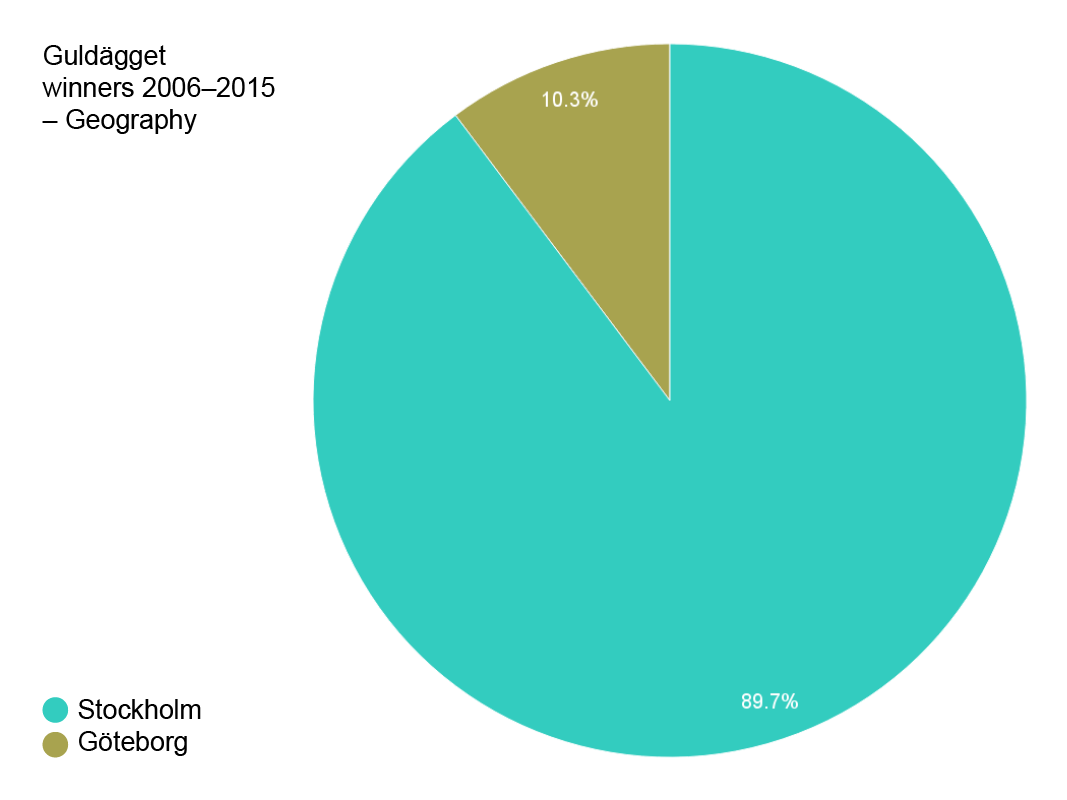
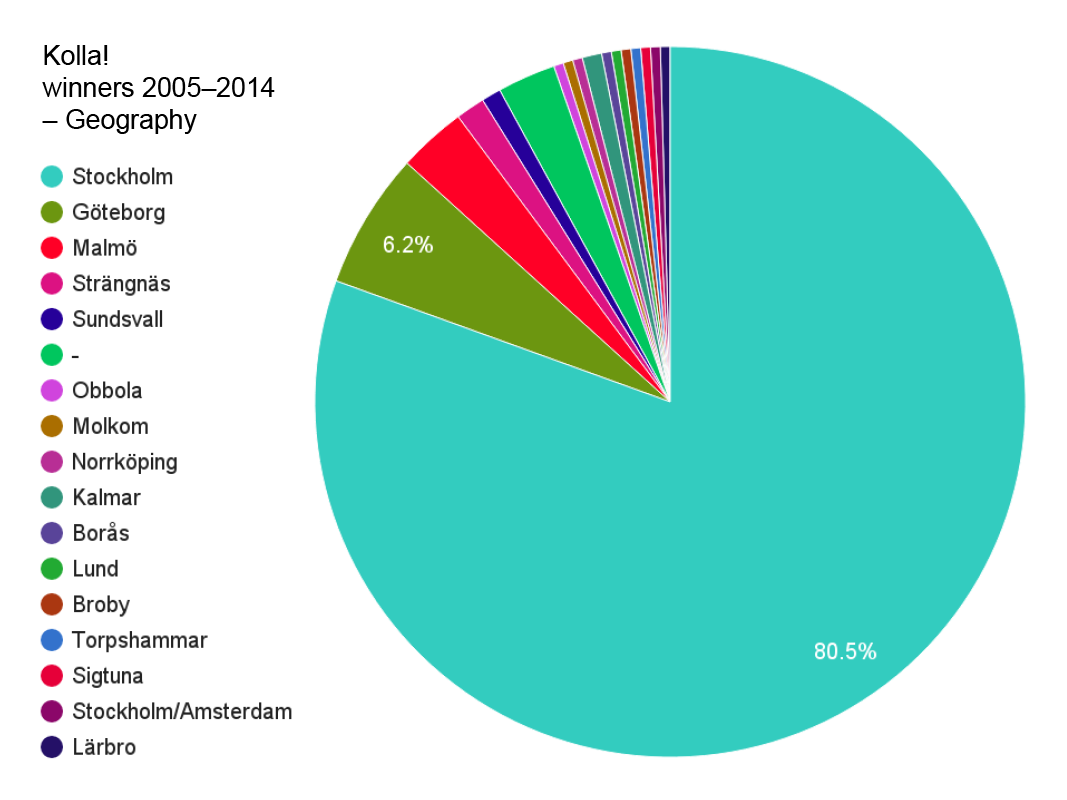
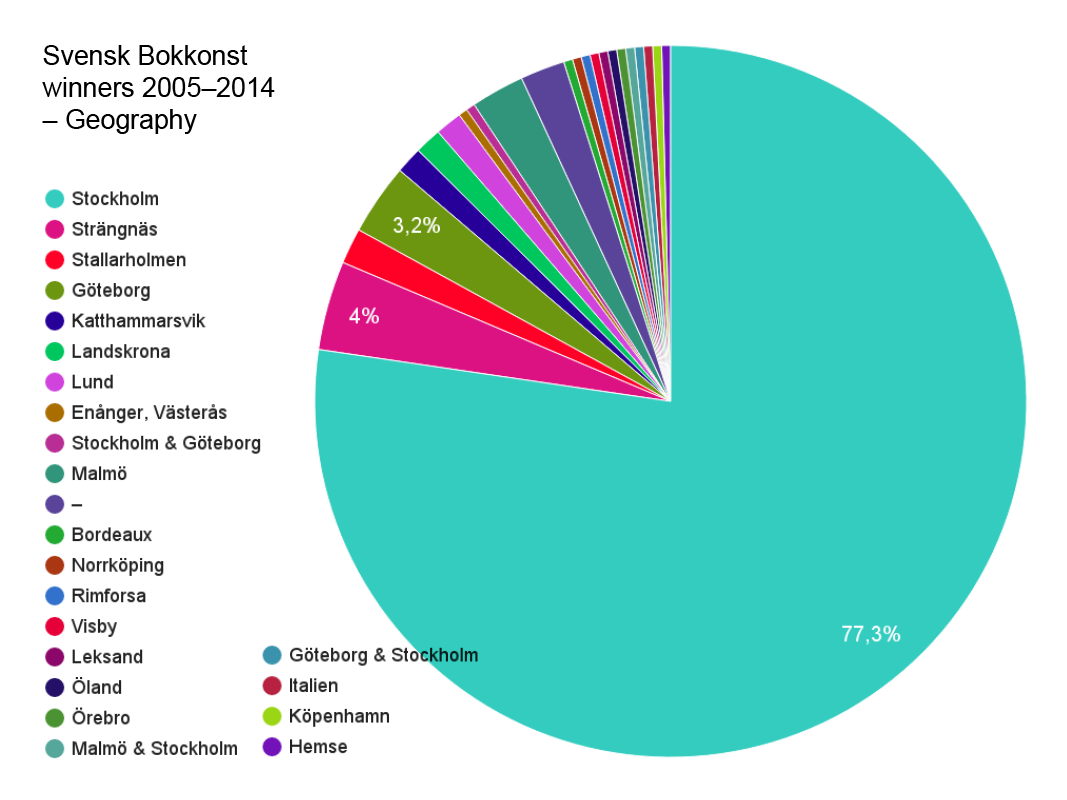
2) Gender
There is a male dominance in all three awards. At Guldägget the pie shows two thirds men and one third women. The difference goes up to three-quarters of men and a quarter of women when we adjust for winning art directors, a hierarchical higher position than that of the graphic designer.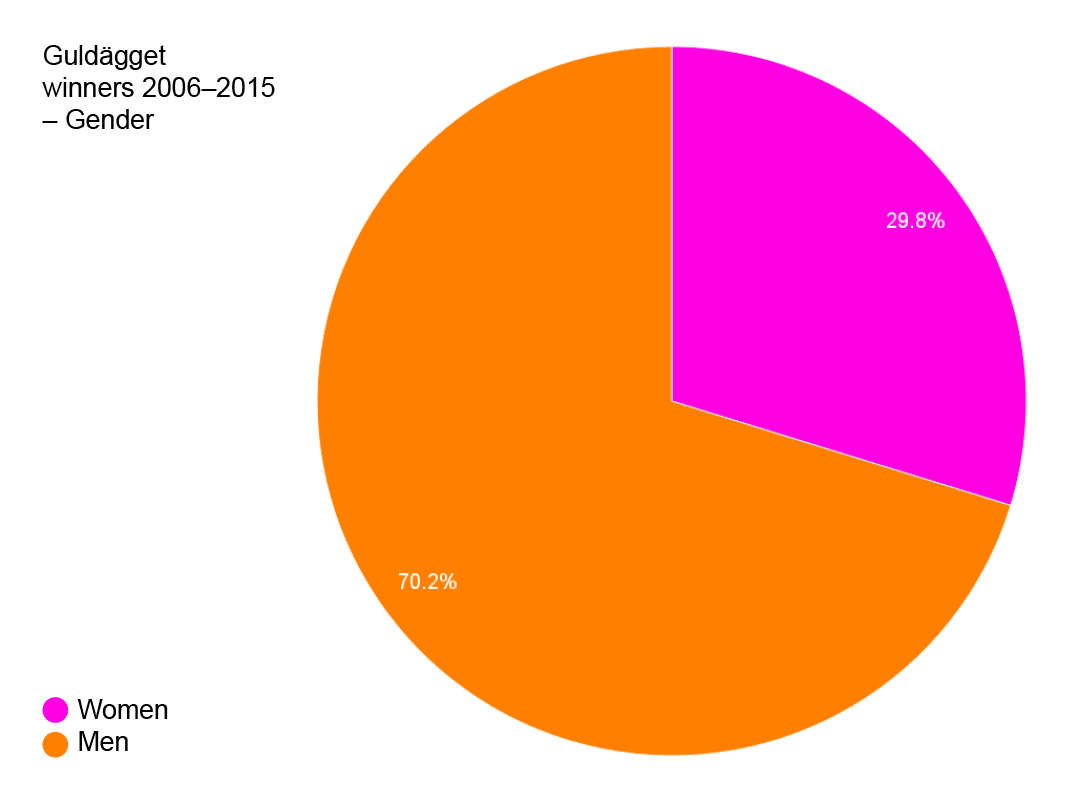
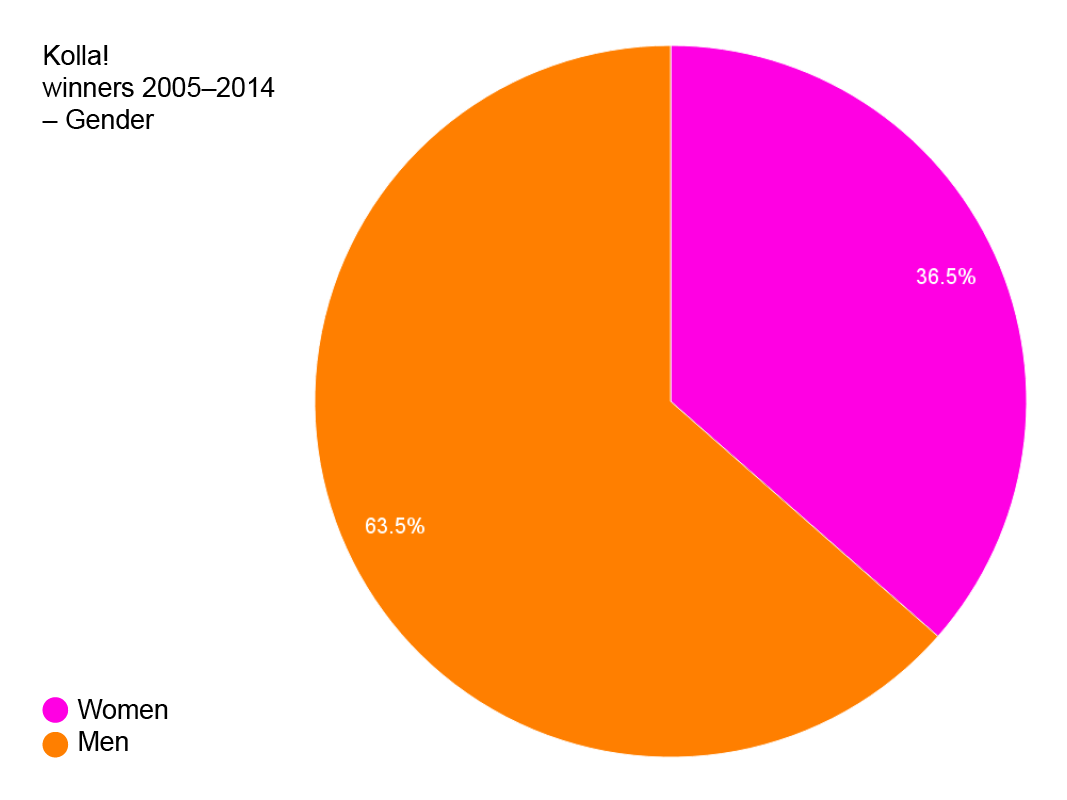
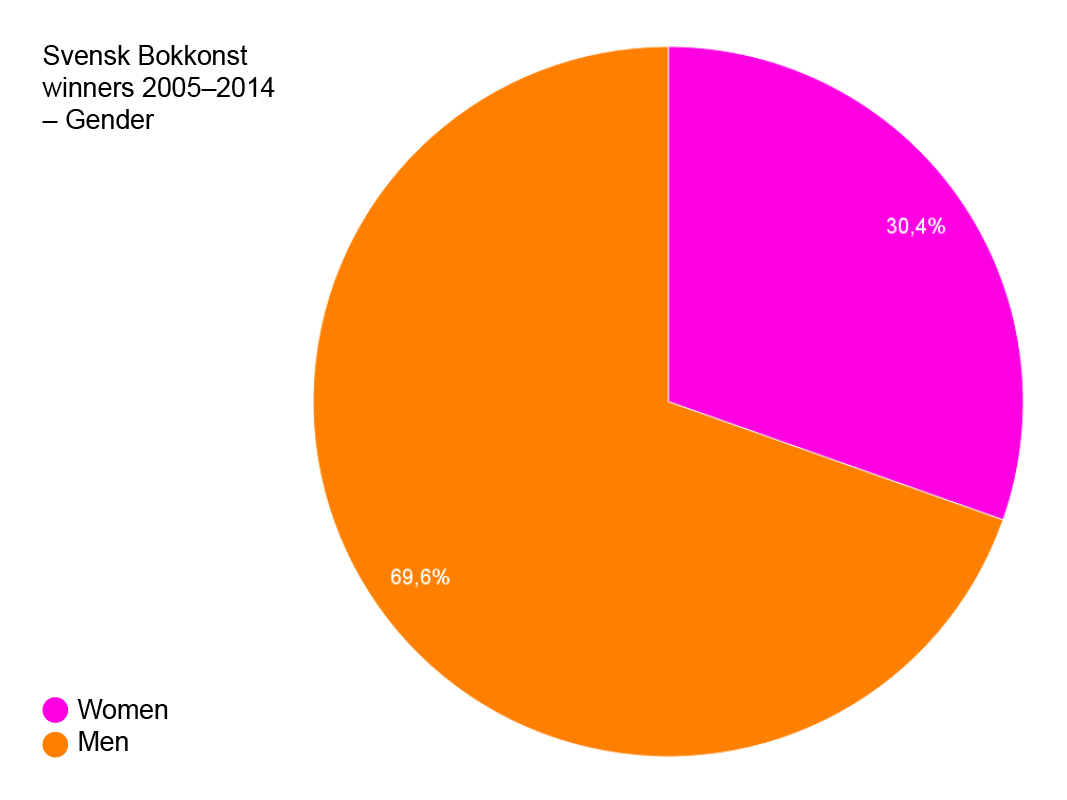
Both the geographical and gendered statistics gave us an expected result; the representation among winners is heavily skewed. We could also see that the same names appear over and over in all three awards. The Swedish graphic design community is fairly small, and we also realized that the names of some practitioners within the field did not occur among the winners or nominees. Was this because their work didn’t appeal to the juries? Or because they decided not to submit work? We decided to find out why.
Interviews
We decided to interview active practioners not visible in award catalogues or among nominees. The ones not competing, who stopped competing or simply never win. What experiences and attitudes could these persons share with us by discussing the personal, physical, emotional experiences of competing, or not competing? We will keep the names of our interviewees anonymous. This part of The Name of the Game study is still in progress and open-ended, so please let us know if you want contribute in any way! Below you find a selection of extracted quotes:
”The point of a competition is that someone is a winner, thus better than everyone else, and I think it's very difficult to say what is a good design and what is a better design. You can’t measure it that way. The work is reviewed by the eyes of a jury, and I don’t find that very interesting. This became very clear to me when was on a jury myself. I had felt apprehensive before, but through some idea about “survival” I had participated in design awards anyway. To get commissions and find a context, even though I didn’t sympathize with the whole setup. But after I being on the jury, I have never participated. My suspicions were correct. That the process is so arbitrary, and that a certain kind of work is favored.”
”I think some people feel that it is so important to always get affirmation. Even if you received that affirmation a bunch of times before. The work is so important. But I think the intoxication is so short, so you want it again and again, even though you won a hundred times before already.”
”Sometimes when I'm on a jury I get the feeling that I'm very weird. That I don’t look at things the way others do. Sometimes no one even understands my comments. There is a very specific way in which you should assess the designs, which I don’t really share. Another aspect of the design competition format is that everything is very simplified, nothing can be complicated. The work should be extremely clear, in a way that I don’t agree design should have to be. It’s a strange context. Also, I feel that the works are assessed not for what they are, but from how well they fit into the “brand” of the award.”
”It wasn’t until I was nominated in Kolla! that I realized I could absolutely not imagine myself going to the ceremony. I generally find it difficult with the glorification of such events, where the industry mingle and try to construct some kind of community which doesn’t necessarily exist. It was like a merit to receive the prize but I didn’t want to have anything to do with the award ceremony.”
”I felt a lot of unease mingling with the crowd at the award ceremony. It always gets very anxious. After that experience I have avoided such events. It’s not that dramatic really, I can actively choose not to participate. I can support myself as a designer or illustrator anyway, so it's not like I feel excluded, it's more of my own choosing. But I have to admit I can still get irritated and frustrated when I see which works are awarded. I feel very ambivalent about it. Maybe I should participate to contribute to some kind of diversity. But I have the opportunity to refrain, so I do.”
”I have never competed, I have always felt very uncomfortable about it. I was told by a teacher to send in my work, because there were so few women participating. She said: women are so bad at competing. Since it was presented as a feminist act, I felt bad about not complying. At the same time I had a strong feeling that it was all wrong, even though I couldn’t explain why.”
Summary
To professional image and design workers – graphic designers, illustrators, advertisers, animators, cartoonists, etc. – awards are a common forum in which to gather, celebrate, and recognize each other’s work. Every year, lists of winners are announced in categories such as best book cover, packaging design, or advertisement campaign.
Competitions and awards do service as exposure to potential clients, as well as to the general public. Many practitioners have been reared into competing already during their education, and after graduation awards are a part of the process of becoming established within the field. Throughout one’s professional career, design awards serve as meriting “quality seals” on one’s CV. Employers and clients, in turn, proudly promote winning award entries as part of their own marketing strategies.
But if we direct the spotlight away from individual winners, what consequences does competing have on our trade as a collective? We have summarized some of the repercussions that became visible while doing our investigation:
Always on top
– the reproduction of “winners”
Feeling addressed and welcomed into a competitive context often presumes an already privileged position. Far from everyone carries the necessary confidence or sense of legitimacy in prestigious contexts and spaces such as awards –“If you cant stand the heat get out of the kitchen”. Competitions are not relieved from the power structures that permeate the rest of society, on the contrary they uphold and solidify existing hierarchies by rewarding that which is already strong and well-exposed. This is confirmed by the fact that the same names and agencies often return among the winners.
Killjoy
– Why it is (almost) impossible to criticize awards
Criticism expressed by anyone who is not the winner (Ie the losers) can easily be dismissed as bitterness. Noone wants to be a bad loser, or a party pooper by rejecting the award show. Many remain silent about how they actually feel about competing. The fear of taking on the role of a sore loser effectively silences critical voices. In such a way, the award format is granted an inherent immunity and continued legitimacy.
Another aspect of this is the close affiliation between awards and clients, if you cant afford to bite the hand that feeds you (trophys), its hard even for “the winners” to speak up against competition.
The award and excellence
– the deceptive connection between competition and quality
Awards rest on the idea that competition is a guarantor of quality. Strongest equals best. It is important to expose the fact that this is an ideological view of quality, servicing the market economy. The inverse of the contest’s prize podium would be a cultural politics that counteracts hierarchies.
Nice! Ugly!
– No time for complexities
When huge amounts of competition entries must be reviewed in a very short span of time, in the jury consideration as well as award ceremonies, the result is trivialization rather than immersion. The short justification texts in the award catalogues leave no space for expansive thought or discourse. Superficial presentations are likely to produce superficial rejection or praise (Nice! Ugly!).
The blunt categorization systems of design awards counteracts critical discussion and immersive understanding of the complexity of image and form production, working conditions, creativity and craftsmanship within the field. Even when the competition is augmented with panel discussions and articles, the fact remains that the podium allows no space for nuances.
Lopsided gameboard
– judging asymmetrical work relations
Within advertising – an industry encompassing large-scale assignments, agencies, and high economic revenue – awards is a well-established tradition. When this tradition is transferred to a different working environment in which freelancing illustrators and designers go up against agencies with massive budgets, timeframes, and work groups, the basic predicament is assymetrical. Winning against the larger player can have a rewarding David vs Goliat effect but in the long run large players are always favoured by maintaining the competition format, while already vulnerable freelancers are pitted against each other, shattering potential unities, the organization of which could enable improved working conditions in the long run.
Hidden agendas
– What is concealed behind the seemingly neutral awards model?
A brief view from the outside may assess design awards as a “neutral” space for determining the scope of a field, despite the fact that examples such as the above-mentioned "lopsided gameboard” contradict this. Other problematic structures that are kept out of view are the fact that competitions that require submission fees enable large players to submit many entries and can obstruct small players from even being able to afford to participate at all.
In addition, different jury groups in different awards, are often composed of the same people over and over again. Ulterior motives of the organizers of design awards, such as self-promotion, are often invisible. Many entries are submitted by employers, since they have everything to gain from winning, and furthermore benefit from a divided, competitive field. Instead of communicating our work to a broader public, design awards mirror a false image, without true insight into actual conditions and problems.
“Best in Sweden”
– Geographic homogenisation, national demarcation
When award ceremonies, recognition, and participation are centred around the capital city, claims of “Sweden’s foremost…” ring untrue. The image of design as a concern for the capital city is emphasized, at the cost of producers located outside of the capital city being not only excluded but also obscured.
In addition, design is often used to strengthen the trademark of Sweden as a nation, and descriptions such as “Sweden’s foremost” are implicated in that promotion. This has an imperialist effect. Both locally, for the reasons mentioned above, and globally, in that it nourishes the idea of national competitiveness – a contemporary colonialism supported on grounds of nationalist argumentation.
Being included in a context where one is taught to identify as “Swedish” enhances the national state borders and impedes other identifications and unities. To enable global solidarity, we need to create and dwell in contexts that do not employ the national state as a boundary and qualification.
“Democratization”
– attempts to make the award more egalitarian
In order to deal with the above-mentioned dilemmas, efforts are sometimes made to reform and “democratize” competitions. One such example, aspiring to compensate for the biased position of the jury, are categories wherein the public can vote for “The Audience Choice Award”. The voting process encourages competitors to feel comfortable with exclamations of “vote for me!” in social media, which in turn results in the winner being elected on the basis of network magnitude, visibility, and resources. Instead of democratization, the result becomes yet another enhancement of the already visible, and social media as yet another arena for competition.
We do not see it as progressive that more women, or people with other backgrounds than those represented, would enter and win design awards. We have many times heard that women in the design industry “have to be more bold”. That we should encourage women to compete more, implicitly “behave more like men.”
We find this suggestion problematic, as it direct the light away from the men and instead hold women responsible for the problem. But it also ignores the fact that not attending may actually be a well considered silent opposition towards a system one does not acknowledge.
Reforming awards will never fundamentally make a difference. Like the British philosopher Nina Power said: “What looks like emancipation is nothing but a tightening of the shackles.”
Summary
For many image- and form-makers, working life can be lonely and precarious. Meeting places and forums for discussions and debate are scarce. Combined, these factors drive many to feel that competitions are the sole source of recognition and discourse. We would claim that the competition structure contributes to and simultaneously obscures these dismal conditions by cloaking them in a scrim of success and prestige.
We cannot ignore that the incessant competing endemic to the field of image and design takes part in a larger neoliberal narrative, wherein competition and competing are internalized and normalized early on and across many planes. When we accept competitions as a positive and progressive way to meet, we are simultaneously swallowing a much more indigestible bait, which keeps us effectively caught on the hook.
What gets lost are the many voices, images, and expressions. This is particularly contradictory and disturbing within a trade that is supposed to be driven by creativity and the ability to convey new narratives and images.
By sharing this material we wish to create a foundation from which we can discuss new ways of showing and celebrating a wide spectrum of visual communication and imagination.
Further reading
“Awards are persuasive instruments of control. To enter a competition is to submit to authority, to concede bureaucratic command over a feral cultural terrain. For Barnbrook there is something ‘very conformist about winning an award’. Entering an award is to conform to an edifying hierarchy and to queue for a place in its history.”
“Awards madness”, Jason Grant, eye magazine, Autumn 2008
”För medierna är det intressantare att skriva om ett ämne om man har en tilldragelse som skapar aktualitet, till exempel ett pris. Och såväl kollektivt som individuellt minns vi ofta avgörande ögonblick. Det är så vi skriver vår egen historia, och så vi formar berättelsen om vår framtid.”
”Och vinnaren är”, Kristina Ketola Bore, Tecknaren, November 18, 2014
“Your reward as a winner is seeing your entry reproduced with neither a rationale for its creation nor an explanation for its inclusion.”
“You may already be a winner”, Michael Bierut, Design Observer, August 29, 2005
“Since 1963, the Brno Biennial has showcased excellence in graphic design from around the world. This book attempts to chart the educational background of this recognized excellence, using the profiles of the designers selected for the Biennial’s last five editions as a starting point. Who are they, in terms of nationality, gender and age? Where did they study – in what countries and cities, at what schools, under what economic realities? And how has the Biennial’s composition in any of these terms changed over a period of ten years?”
Off-white Paper by Sulki & Min, 2014
“One thing that troubles me more deeply than anything else is the idea that women have been urged, over the last decade of years, to be as obnoxiously competitive as men under the banner of liberation. I feel, that I have, as a man, an awful lot to learn about the values traditionally associated with women, about relationship and cooperation and so on. And it pains me deeply that it has been turned around, that men instead of becoming the students they have become the teachers. It is not a very productive response to sexism, to become like the people we are trapped by. These norms are not challeneged by becoming the norms to which everyone aspire. There are zero evidence that this stuff is inborn or in the genes.”
No Contest: The Case Against Competition, Alfie Kohn, 1986/1992